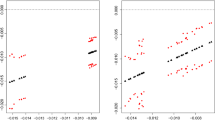Abstract
In this paper we introduce a new econometricapproach to analyzing recreational site choicedata, the Dirichlet multinomial model. Thismodel, which nests the standard conditionalmultinomial logit model, can accommodateover-dispersed data and may provide moreefficient estimators of coefficients andconsequent welfare measures than the standardconditional logit model, which is so widelyused in the Random Utility Model approach torecreation demand. We illustrate thisDirichlet approach using a data set of rockclimbers in Scotland, and study the impacts onper-trip consumers surplus of alternativemanagement strategies for popular rock climbingsites. Results show that the Dirichletmultinomial approach produces coefficient andwelfare estimates having smaller samplingvariability in this case. We also compareclassical welfare measures with their posteriorequivalents, which allow for welfare changes tobe dis-aggregated.
Similar content being viewed by others
References
Cavlovic, T., R. Berrens, A. Bohara, P. Jakus and W. D. Shaw (2002),‘Valuing the Loss of Rock Climbing Access in Wilderness Areas: A National-level Random Utility Model’ Land Economics 78(1), 103-120.
Gourieroux, C., A. Monfort and A. Trognon (1984),‘Pseudo Maximum Likelihood Methods: Theory’ Econometrica 52, 681-700.
Greene, W. H. (2000), Econometric Analysis (Fourth edition). Prentice Hall.
Grijalva, T., R. Berrens, A. Bohara and W. D. Shaw (2002),‘Testing the Validity of Contingent Behaviour Trip Responses’ American Journal of Agricultural Economics 84(2), 401-414.
Hanemann, W. M. (1999),‘Welfare Analysis with Discrete Choice Models’ in J. A. Herriges and C. L. Kling, eds., Valuing Recreation and the Environment. Edward Elgar.
Hanley, N., G. Koop, R. Wright, B. Alvarez-Farizo and C. Nevin (2000),‘Go Climb a Mountain: An Application of Recreation Demand Models to Rock Climbing in Scotland’ Journal of Agricultural Economics 52(1), 36-52.
Hanley, N., B. Alvarez-Farizo and W. D. Shaw (2002),‘Rationing an Open-access Resource: Mountaineering in Scotland’ Land Use Policy 19, 167-176.
Hanley, N., R. Wright and G. Koop (2002)‘Modelling Recreation Demand Using Choice Experiments: Rock Climbing in Scotland’ Environmental and Resource Economics 22, 449-466.
Hellerstein, D. (1991),‘Using Count Data Models in Travel Cost Analysis with Aggregate Data’ American Journal of Agricultural Economics 73, 860-867.
Highlands and Islands Enterprise (1996), The Economic Impacts of Hillwalking, Mountaineering and Associated Activities in the Highlands and Islands of Scotland. Produced by Jones Economics and published by Highlands and Islands Enterprise, April.
Johnson, N. L., S. Kotz and A. W. Kemp (1992), Univariate Discrete Distributions. John Wiley & Sons.
Johnson N. L., S. Kotz and N. Balakrishnan (1997), Discrete Multivariate Distributions. John Wiley & Sons.
Kim, B. S. and B. H. Margolin (1992),‘Testing Goodness of Fit of a Multinomial Model Against Overdispersed Alternatives’ Biometrics 48, 711-719.
Leonard, T. and J. S. J. Hsu (1999). Bayesian Methods. Cambridge University Press.
Lwin, T. and J. S. Maritz (1989),‘Empirical Bayes Approach to Multiparameter Estimation with Special Reference to Multinomial Distribution’ Annals of the Institute of Statistics and Mathematics 41, 81-99.
McCullagh, P. and J. A. Nelder (1989), Generalized Linear Models (Second edition). Chapman & Hall.
McFadden, D. (1974),‘Conditional Logit Analysis of Qualitative Choice Behavior’ in P. Zarembka, ed., Frontiers in Econometrics. Academic Press.
McFadden, D. (1999),‘Computing Willingness-to-pay in Random Utility Models’ in J. R. Melvin, J. C. Moore and R. Riezman, eds., Trade, Theory and Econometrics. Routledge.
Mosimann, J. E. (1962),‘On the Compound Multinomial Distribution, the Multivariate ß-distribution, and Correlations among Proportions’ Biometrika 49, 65-82.
Shaw, W. D. and P. Feather,‘Possibilities for Including the Opportunity Costs of Time in Recreation Demand Systems’ Land Economics 75, 592-602.
Shaw, W. D. and P. Jakus (1996),‘Travel Cost Models of the Demand for Rock Climbing’ Agricultural and Resource Economics Review 25, 133-142.
White, H. (1982),‘Maximum Likelihood Estimation of Misspecified Systems’ Econometrica 50, 1-25.
Wightman, A. (1996), Scotland's Mountains: An Agenda for Sustainable Development. Perth: Scottish Countryside and Wildlife Link.
Wilson, J. R. (1986),‘Approximate Distribution and Test of Fit for the Clustering Effect in the Dirichlet Multinomial Model’ Communications in Statistics-Theory & Methods 15, 1235-1249.
Author information
Authors and Affiliations
Corresponding author
Rights and permissions
About this article
Cite this article
Shonkwiler, J.S., Hanley, N. A New Approach to Random Utility Modeling using the Dirichlet Multinomial Distribution. Environmental and Resource Economics 26, 401–416 (2003). https://doi.org/10.1023/B:EARE.0000003597.88521.24
Issue Date:
DOI: https://doi.org/10.1023/B:EARE.0000003597.88521.24




